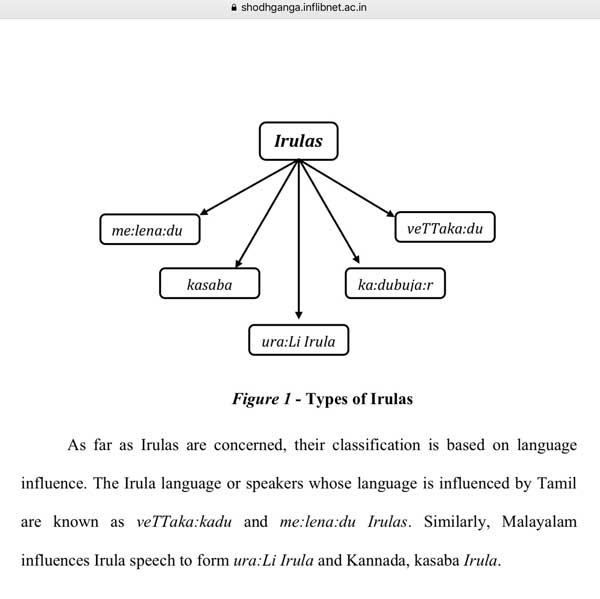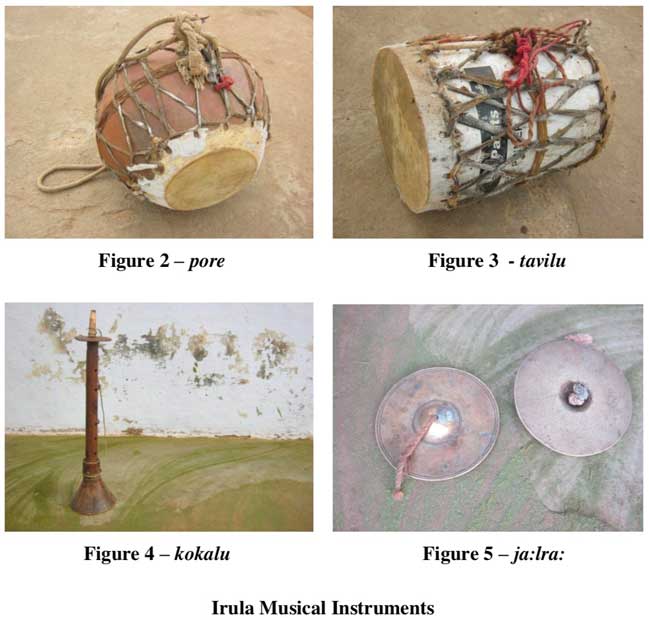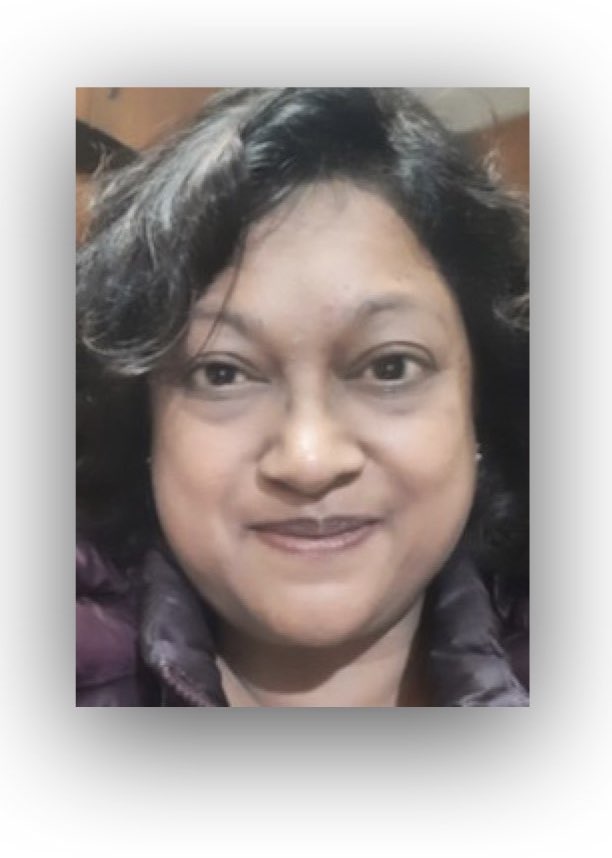3.4. The Irula Language | Downlowad the full PhD thesis by P. Suresh here >>
The status of the Irula language as a separate language from Tamil or as a divergent form of Tamil has been debated by scholars. Irula language belongs to the Dravidian family. Diffloth (1968) had concluded that Irula is closely related to Tamil. Louis had suggested that Irula is a dialect of Tamil with more Kannada language words. But Kamil Zevelibil (1973) had treated the Irula as a separate language. S. V. Shanmugam (1942) also defined Irula as a separate language in South Dravidian family. R. Periyalwar (1976) who did his doctorate in the Irula language had noted some unique features in the phonological and grammatical structure of the language and had concluded that Irula must stand as a separate language. Irulas are bilinguals as they speak Tamil. Generally, they do not speak Irula in the presence of non-Irulas. Due to their social insecurity and inferiority complex they think that their speech is not considered as a prestigious language.
3.5. Types of Irulas
According to Zvelebil Kamil (1979), Irulas can be divided into five subgroups based on their socio-cultural and dialectical variations […]
As far as Irulas are concerned, their classification is based on language influence. The Irula language or speakers whose language is influenced by Tamil are known as veTTaka:kadu and me:lena:du Irulas. Similarly, Malayalam influences Irula speech to form ura:Li Irula and Kannada, kasaba Irula.
Irulas of Coimbatore district say that the Irulas of Anamalai hills and Attapady valley of Kerala state belong to one group. All of them are referred by a common term veTTaka:du Irulas. R. Periyalwar (2012) has included Irulas of Coonoor taluk (Nilgiri district) in veTTaka:du Irulas category. The Irulas of Coimbatore district can be grouped into two types, those living in the reserved forest areas, and those living in the plains.

3.6. Clan Divisions of the Irula
There are twelve clans or kulam in Irula […]
People of the tribal community admit that now-a-days, they never follow clan system for arranging marriages except when considering the brother group and the brother-in-law group. Thus, their social divisions have become obscure. A few of the Irula have recently developed some sort of differentiation among themselves on the basis of economic, educational and government houses pattern of living.
In the early Irula community there were twelve clans out of which seven were considered to be important. In the Irulas community a function or any ceremony is conducted only if all of the seven clans are present during the occasion. […]
3.8. Ethnographic Description of the Irula
3.8.1. Musical InstrumentsIrulas are good musicians, displaying skills both in vocal and instrumental music. Instrumental music is one of their chief hobbies and is indispensable at weddings, funeral rites and social festivals. The Irula make their own drums and wind instruments for their musical enjoyment. The musical instruments are of six types: kokalu, na:gacura, pore, tavilu, tambaTTe and jalra:. The kokalu is a kind of flute (a kind of clarinet) made either of bamboo or bamboo with wood and metal. This flute is the main instrument played on the occasions of marriage, burial and festivals. The na:gacura resembles the snake charmer’s wind pipe. The pore is made up of clay pot with animal skin in centre clay pot and both side tied tightly with rough animal skin it is like spherical shape. The tavilu is made up of drums with animal skin, one drum covered with both side with animal skin. The tambaTTe is also made up with animal hide it is in circular shape, and the ja:lra: is two metals jointed with a string, it is side instrument. All these musical instruments are made of indigenous materials.
3.8.2. Folk Dances
Irulas perform group dancing on festival days and as a part of the marriage, funeral, and puberty rites. They do not usually sing while dancing, but do the dance to the tune played on drums and pipes. Men, women and children stand in separate concentric circles around those who play the instruments. Men raise their hands and wave them before their faces in a cross-wise manner. This is followed by straight vigorous and repeated movements. The women do their part by raising their hands to shoulder level with open palms, moving them from side to side rhythmically and rotating the wrists. The children follow the movements of the women. While making these gestures they move about in circles adjusting their steps to the rhythm of the drum-beat. The pipers play different tunes to suit the occasion. Funeral dances which are performed at night are especially thrilling to a newcomer. A popular type of Irula dance is called arakkole a:tta.

3.10. Cultural Forms of the Irula People
The life cycle rituals of the Irulas are markedly different from that of the other Hindu or Christian communities. They perform the life cycle ceremonies with the help of their women by well-established cultural patterns and do not depend on outside intervention to keep itself going. They celebrate child birth, naming ceremony, ear boring ceremony, age attainment or puberty, marriage and death ceremonies. Except for marriage ceremony, for other ceremonies they spend very less amount and the participation of the women is a must one in all life cycle ceremonies.
3.15. Discussion
In the light of the above discussion, Irula tribe has their own culture, rituals, attire, beliefs, lifestyle and most important thing is their clan system. During the course of time they have started losing their identity in terms of language, fables, traditional songs and the vocabulary of the possessions in their practices and premises. Especially, rituals have been affected and influenced by the plain people with whom the Irula people have radial and star connectivity. It is found that the identity of the Irula is being maintained by the people whose age is above fifty. The study has revealed that the social, cultural and linguistic aspects have been affected by the effects of the practices of the plain people.
Source: PhD thesis by P. Suresh titled “Lexical Structure Of Irula Language”, Ch. 3 (Socio-Cultural Perspective on Irula Tribes), Department of Linguistics, Bharathiar University 2014
URL: https://hdl.handle.net/10603/98333
Date visited: 20-11-19

“[A] common perception of conversion, prevalent in India, is that all conversions take place only among deprived lower caste or tribal groups, which are considered more susceptible to allurement or coercion. The reality of upper caste conversions is ignored in this climate of cynicism.”– Dr. Ivy Imogene Hansdak in Pandita Ramabai Saraswati: the convert as ‘heretic’ | More about the effects of “casteism” >>
Research the above issues with the help of Shodhganga: A reservoir of theses from universities all over India, made available under Open Access >>
Reports in the Indian press | List of periodicals included in this search >>
Search tips
Combine the name of any particular state, language or region with that of any tribal (Adivasi) community.
Add keywords of special interest (health, nutrition endangered language, illegal mining, sacred grove); learn about the rights of Scheduled Tribes such as the “Forest Rights Act” (FRA); and the United Nations “Declaration on the Rights of Indigenous Peoples”, “Universal Declaration of Human Rights”, “women’s rights”, or “children’s right to education”.
Specify any other issue or news item you want to learn more about (biodiversity, bonded labour and human trafficking, climate change, ecology, economic development, ethnobotany, ethnomedicine, global warming, Himalayan tribe, hunter-gatherers in a particular region or state, prevention of rural poverty, water access).
For official figures include “scheduled tribe ST” along with a union state or region: e.g. “Chhattisgarh ST community”, “Scheduled tribe Tamil Nadu census”, “ST Kerala census”, “Particularly Vulnerable Tribal Group Jharkhand”, “PVTG Rajasthan”, “Adivasi ST Kerala”, “Adibasi ST West Bengal” etc.
In case the Google Custom Search window is not displayed here try the following: (1) toggle between “Reader” and regular viewing; (2) in your browser’s Security settings select “Enable JavaScript” | More tips >>
Tip: click on any red marker for details on endangered languages in a particular region of India.
Please note: the facts and figures cited (via hyperlinks) links call for updates and fact checking >>
Cultural invisibility – India’s 600 potentially endangered languages | Linguistic Survey of India (official website) >>